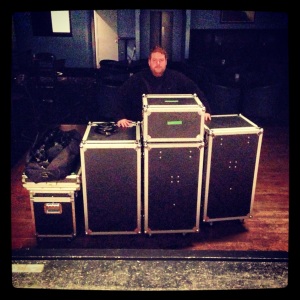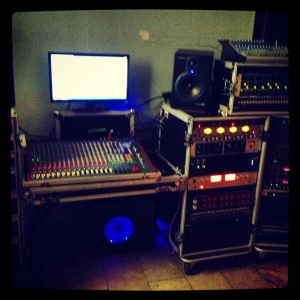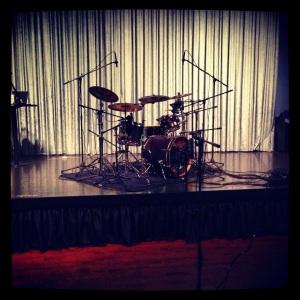Finally time to start recording the final album! First up is drums.
Like I said in the last post, we did two rounds of demos for each song, so we’re pretty prepared going into this tracking session. We have the clicks and tempos already worked out and the drummer knows the parts so well, he can play the songs just by click with no other instrumentation (much tougher than it sounds!). With everything already taken care of in advance, that leaves us to focus solely on capturing the best performance we can.
 Before we can record a single take, though, we need to do a ton of setup. My main (home) studio has a low 10′ ceiling, so it isn’t suitable or ideal for recording drums. We wanted something big and epic-sounding. When you hit the toms, we wanted it to sound like canons blasting. There’s a former-church-turned-nightclub near us where I’ve done live sound in the past. I’m very familiar with the room and knew it would give us what we wanted.
Before we can record a single take, though, we need to do a ton of setup. My main (home) studio has a low 10′ ceiling, so it isn’t suitable or ideal for recording drums. We wanted something big and epic-sounding. When you hit the toms, we wanted it to sound like canons blasting. There’s a former-church-turned-nightclub near us where I’ve done live sound in the past. I’m very familiar with the room and knew it would give us what we wanted.
Traditional churches were built, by design, to allow sounds to carry sounds throughout the structure, particularly a preacher’s voice. After all, with many churches being well over a hundred years old, there were no such things as PA systems when they were built — amplification was achieved acoustically. The church we recorded in was well over a hundred years old and had a huge 40’+ tall cathedral ceiling. If this were still a church, it’d have been too echo-y to record. However, since this church was shutdown and converted into a nightclub, it had just enough objects and tables/chairs/etc. in it to diffuse most of the sound. What we were left with was a large room that was lively, but not overly so, with a nice big boom sound and pleasant echoing, but again, not so much that it’d be overkill.
 So, we went on location to the church to record drums. I packed up the core pieces of my studio and setup shop in a side room connected to the big room. The control room wasn’t ideal, but it provided me enough separation from the live room that I could hear what was being recorded. And really, that’s the main thing: If you can monitor in a nicely tuned room, that’s icing on the cake, but just being able to hear clearly is enough to get you through almost any job.
So, we went on location to the church to record drums. I packed up the core pieces of my studio and setup shop in a side room connected to the big room. The control room wasn’t ideal, but it provided me enough separation from the live room that I could hear what was being recorded. And really, that’s the main thing: If you can monitor in a nicely tuned room, that’s icing on the cake, but just being able to hear clearly is enough to get you through almost any job.
I ended up taking 2 large flights cases of preamps and compressors, 1 large case of mics/cables/tools/etc, a 6-space rack for DI/splitters/headphone distrubution/etc, a trunk for monitors/computer/computer monitor, a mixing console case and about 2 dozen mic stands. Not exactly a portable setup, but it was the bare minimum I needed to track this thing.
 While I was unpacking and setting up the make-shift control room, our drummer, JT Penderville, was working with Buddy Hoebler, our drum tech, to put new heads on the drums and tune it. They put a Remo Black X head on the snare and Evans EC2 SST Clear heads on the rack and floor toms. JT plays a 4 piece kit, with just a rack and floor tom, so he has a pretty minimal drum setup. From a recording perspective, it’s very nice because he doesn’t have anything unnecessary on the kit — what’s there is used and used extensively. So many drummers go overboard with unnecessary hardware and drums, it makes it tough to really capture a good stereo image of a kit. Not the case here. For cymbals, he used 13″ Sabian AAX hats, 17″ Sabian AAX Studio crash, 18″ Sabian AAX X-plosion crash, Sabian Rock Pro Ride and an 18″ Wuhan China.
While I was unpacking and setting up the make-shift control room, our drummer, JT Penderville, was working with Buddy Hoebler, our drum tech, to put new heads on the drums and tune it. They put a Remo Black X head on the snare and Evans EC2 SST Clear heads on the rack and floor toms. JT plays a 4 piece kit, with just a rack and floor tom, so he has a pretty minimal drum setup. From a recording perspective, it’s very nice because he doesn’t have anything unnecessary on the kit — what’s there is used and used extensively. So many drummers go overboard with unnecessary hardware and drums, it makes it tough to really capture a good stereo image of a kit. Not the case here. For cymbals, he used 13″ Sabian AAX hats, 17″ Sabian AAX Studio crash, 18″ Sabian AAX X-plosion crash, Sabian Rock Pro Ride and an 18″ Wuhan China.
With the drums re-skinned, tuned, and my control room setup, we were ready to start mic’ing the kit. I’ll detail the gear and setup drum-by-drum in the next handful of posts.
